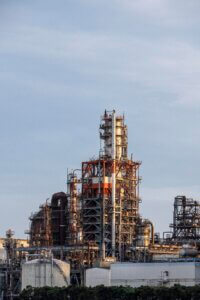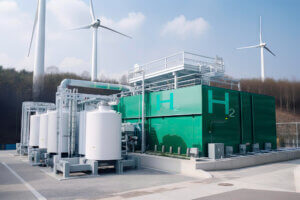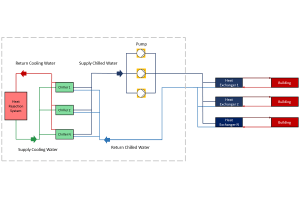Combined Pressure Surge and Dynamic Stress Analysis
Introduction
At BASF Antwerp a steel pipeline was under construction, this pipeline was to be used for the offloading of naphtha from ships arriving at a jetty. The pipeline is 1.6 km long with several pipe bridges. The jetty contains Emergency Release Couplers (ERC), being used to prevent the spoil of naphtha if the ship moves too far from the jetty. A surge analysis was performed to assess the capability of the pipeline for different transient upset scenarios. Subsequently a dynamic stress and flexibility study was performed based on the calculated pressure surges.
Analysis
A transient one-dimensional fluid model of the entire pipeline from the loading arm up to the storage tank was created in the software package BOSfluids. BOSfluids was used to simulate various upset scenarios including rapid valve closure of the ERC, emergency pump tripping of the ship’s onboard pump, and valve closure to prevent overflow of the naphtha storage tank.
The transient unbalanced forces that were a result of the pressure surges were extracted from the BOSfluids simulations. These forces were applied to a piping model in the dynamic time-history solver of CAESAR II. For the dynamic analysis a detailed stress model was created, which included the steel bridge structures so that their stiffness was not over estimated. The dynamic stresses, displacements and support reactions caused by the various transient upset conditions were calculated and assessed.

Results
The results of the surge analysis show that the most critical transient scenario is the rapid closure of the ERC valve located in the loading arm. In this situation the pressure downstream of the closed ERC valve drops rapidly to vapour pressure level. As a result of this drop in pressure, some of the downstream fluid is vapourised. On account of the pressure difference with elevation, this vapourisation occurs predominantly in the elevated parts of the system.
When the flow is sufficiently decelerated the pressure recovers from vapour pressure and the vapour cavities begin to condense. The implosion of these cavities in the elevated sections leads to collision of two fluid columns. These collisions cause large amplitude pressure waves that travel through the system. These pressure waves cause large unbalanced forces in between elbow-pairs of the piping system. Dynamic stress calculations showed that without modification these forces would lead to excessive stresses which did not conform with the design code.
The solution proposed by Dynaflow Research Group (DRG) was to reduce the speed at which the liquid columns collide with each other, by initiating the closure of a downstream valve shortly after the emergency shutdown valve was closed. This solution eliminated the large unbalanced forces alongside the stresses arising within the system, conforming the pipeline to within design code limits.



